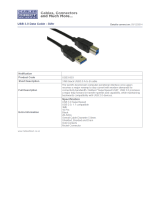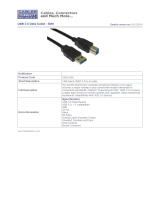
1 Working on your computer............................................................................................................ 5
Safety instructions................................................................................................................................................................ 5
Turning off your computer — Windows 10....................................................................................................................... 5
Before working inside your computer................................................................................................................................. 5
After working inside your computer....................................................................................................................................6
2 Technology and components......................................................................................................... 7
HDMI 1.4..................................................................................................................................................................................7
USB features.......................................................................................................................................................................... 7
3 Removing and installing components............................................................................................ 10
Recommended tools............................................................................................................................................................ 10
Screw list and images.......................................................................................................................................................... 10
System board layout.............................................................................................................................................................11
Cover..................................................................................................................................................................................... 12
Removing the cover.......................................................................................................................................................12
Installing the cover......................................................................................................................................................... 13
Front Bezel............................................................................................................................................................................15
Removing the front bezel..............................................................................................................................................15
Installing the front bezel................................................................................................................................................ 17
Hard drive..............................................................................................................................................................................19
Removing 3.5 inches hard drive assembly - optional.................................................................................................19
Installing 3.5 inches hard drive assembly - optional.................................................................................................. 22
Removing the 2.5 inches hard drive assembly - optional.........................................................................................25
Installing 2.5 inches hard drive assembly - optional.................................................................................................. 28
Removing the M.2 PCIe Solid State Drive - optional.................................................................................................31
Installing the M.2 PCIe SSD - optional........................................................................................................................32
Optical drive......................................................................................................................................................................... 33
Removing optical drive assembly.................................................................................................................................33
Installing optical drive assembly...................................................................................................................................35
WLAN card........................................................................................................................................................................... 37
Removing WLAN card...................................................................................................................................................37
Installing WLAN Card.................................................................................................................................................... 38
Memory modules................................................................................................................................................................. 39
Removing memory module...........................................................................................................................................39
Installing the memory module...................................................................................................................................... 40
Expansion card.....................................................................................................................................................................40
Removing the PCIe expansion card............................................................................................................................ 40
Installing the PCIe expansion card...............................................................................................................................42
Optional card........................................................................................................................................................................44
Removing the optional card......................................................................................................................................... 44
Installing the optional card............................................................................................................................................46
Power supply unit................................................................................................................................................................ 48
Removing power supply unit........................................................................................................................................ 48
Contents
Contents 3






















